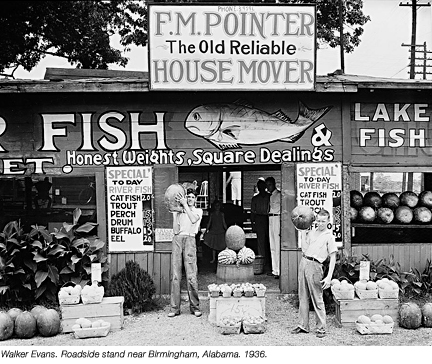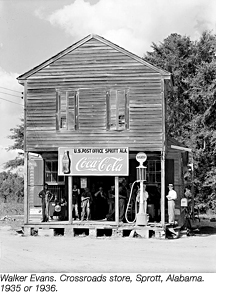
An interesting thing happened on my way to what I thought I was going to write about this week. Kristen over at Gezellig Girl did a quick post on the WPA—the Works Progress Administration, which later became the Work Projects Administration. Whatever you call it, it helped put a lot of Americans back to work during the Depression. And it helped strengthen the country’s infrastructure, building highways, streets, public buildings, airports, utilities, small dams, sewers, parks, libraries and more.
It also put a lot of artists to work, primarily in the creation of murals for all these public buildings. And that got me thinking about another of the New Deal programs, the Farm Security Administration (FSA), and one of my favorite photographers of all times, Walker Evans.
Evans was one of the photographers hired by the FSA to document the struggles of the rural poor and migrant agricultural workers during the Depression. He worked mainly in the south, creating sensitive portraits of the dispossessed and perfectly capturing a time and place. In the process, he pioneered the documentary tradition in photography.
 For me, his photographs of commercial architecture and scenes—shot formally and usually head on with an 8×10 view camera, but somehow often feeling almost matter-of-fact—just grabbed me by the lapels the first time I saw them, gave me a good shake and said, “Everything’s important. Everything’s worth taking a second look at. Pay attention.” I’ve been trying to do that ever since.
For me, his photographs of commercial architecture and scenes—shot formally and usually head on with an 8×10 view camera, but somehow often feeling almost matter-of-fact—just grabbed me by the lapels the first time I saw them, gave me a good shake and said, “Everything’s important. Everything’s worth taking a second look at. Pay attention.” I’ve been trying to do that ever since.
And we all own these photos. How cool is that? The photographs done for the FSA are now in the Library of Congress. Which means we Americans own them. Over the years, I’ve ordered a number of prints made from Walker Evans’ original 8×10 negatives for a very nominal fee—I think 24 bucks or so for a black and white 8×10 last time I bought one. They’re not vintage prints made by Evans or even printed on fiber-based paper—they’re made by photo technicians at the Library of Congress, printed on resin coated paper. But they’re still photographic prints, his images made from his original negatives. By now, they may be doing them digitally—seventysomething-year-old negatives need protecting, after all.
If all this gets you as jazzed as it does me, you can find out more at the Library of Congress online photography catalog.
And as it happens, one of my favorite photographers of all times is also the author of one of my favorite quotes of all times. Here it is.
“Stare. It is the way to educate your eye, and more. Stare, pry, listen, eavesdrop. Die knowing something. You are not here long.” —Walker Evans
Leave a comment